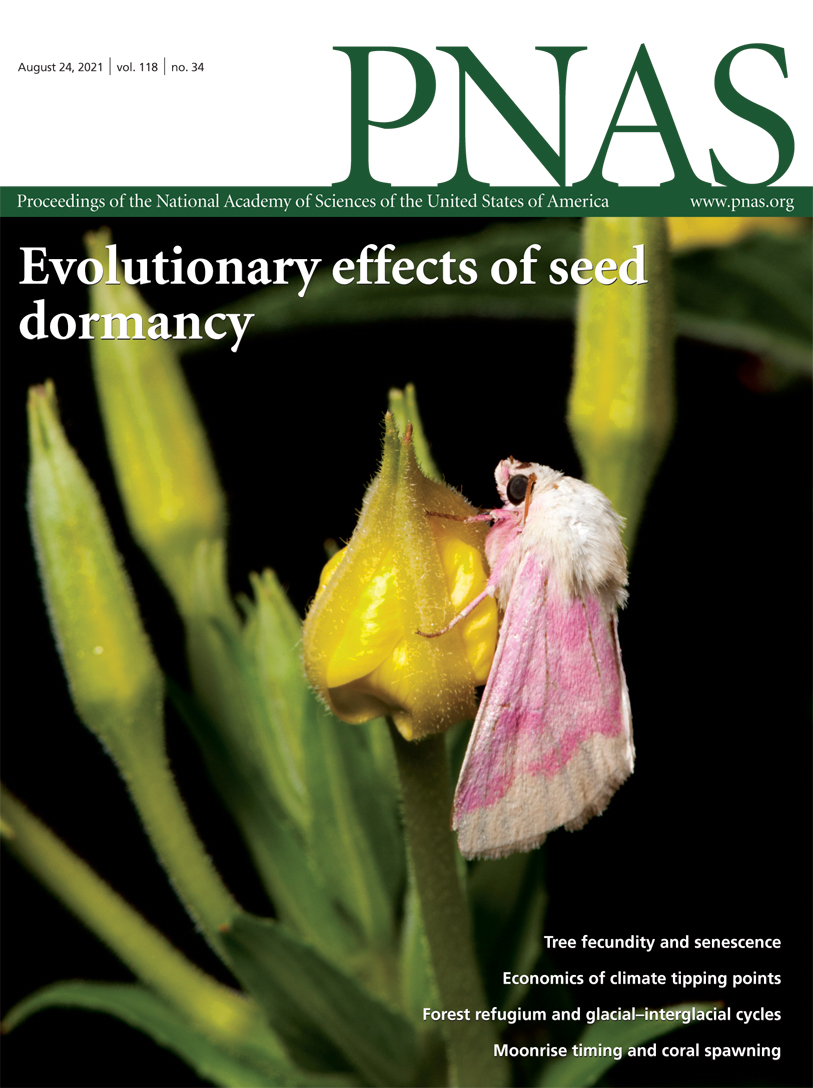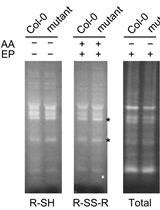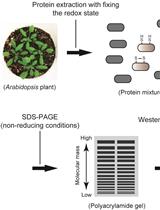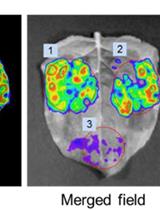- EN - English
- CN - 中文
In vitro Auto- and Substrate-Ubiquitination Assays
体外自体和底物泛素化测定
(*contributed equally to this work) 发布: 2022年04月05日第12卷第7期 DOI: 10.21769/BioProtoc.4368 浏览次数: 3399
评审: Wenrong HeMin CaoYuan Wang
Abstract
The precise regulation of the homeostasis of the cellular proteome is critical for the appropriate growth and development of plants. It also allows the plants to respond to various environmental stresses, by modulating their biochemical and physiological aspects in a timely manner. Ubiquitination of cellular proteins is one of the major protein degradation routes for maintaining cellular protein homeostasis, and ubiquitin E3 ligases, components of ubiquitin ligase complexes, play an important role in the selective degradation of target proteins via substrate-specific interactions. Thus, understanding the role of E3 ligases and their substrate regulation uncovers their specific cellular and physiological functions. Here, we provide protocols for auto- and substrate-ubiquitination analyses that utilize the combination of in vitro purified E3 ubiquitin ligase proteins and immunoprecipitation.
Keywords: Ubiquitination (泛素化)Background
Ubiquitination is a post-translational modification in which ubiquitins, small regulatory proteins found in most eukaryotes, are covalently attached to cellular proteins, resulting in the proteolysis of the cellular proteins via the 26S proteasomes (Sharma et al., 2016; Cappadocia and Lima, 2018). Ubiquitination consists of sequential and cooperative actions of three enzymes that catalyze the attachment of ubiquitins to substrate proteins: E1 ubiquitin-activating enzymes, E2 ubiquitin-conjugating enzymes, and E3 ubiquitin-ligating enzymes. Among these enzymes, E3 ubiquitin-ligating enzymes (also called E3 ubiquitin ligases) provide substrate-specific recognition, which results in the modulation of the homeostasis of a specific cellular protein. The auto- and substrate-ubiquitination are key analyses to understand the function of E3 ubiquitin ligases, as well as their substrate recognition and regulation. Recently, we used auto- and substrate-ubiquitination assays to analyze the functional relationship of Seven-in-Absentia of Arabidopsis 2 (SINAT2), a RING-domain containing E3 ubiquitin ligase involved in stress response, and Arabidopsis ACC synthase 5 (ACS5), a rate-limiting enzyme in ethylene biosynthesis (Lee et al., 2021). Here, we describe protocols for auto-ubiquitination of SINAT2 and SINAT2-mediated ubiquitination of ACS5. Our protocols utilize in vitro purified E3 ubiquitin ligases and immunoprecipitated substrate proteins from a heterogeneously expressed system. Conventionally, substrate ubiquitination assays include purified recombinant substrate proteins and E3 ligases, yielding desired results. However, our protocol utilizes immunoprecipitated substrate proteins expressed from plants. This approach allows researchers to conduct ubiquitination assays for substrate proteins with common problems during recombinant protein expression in E. coli and other expression systems.
Materials and Reagents
Tris-HCl (Dot Scientific Inc., catalog number: DST60040-5000)
CaCl2 (Fisher Bioreagents, catalog number: C79-500)
Adenosine 5’-triphosphate (ATP) (New England Biolabs, catalog number: P0756S)
DTT (Roche, catalog number: 3483-12-3)
MES Free acid monohydrate (Gold Biotechnology, catalog number: M-090-500)
MgCl2 (Fisher Bioreagents, catalog number: BP-214-500)
3',5'-Dimethoxy-4'-hydroxyacetophenone (Acetosyringone) (Acros Organics, catalog number: 115540050)
P19 plasmid
Liquid nitrogen
NaCl (Fisher Bioreagents, catalog number: BP358-10)
EDTA, pH 8.0 (VWR, catalog number: BDH4528-500GP)
Phenylmethaneesulfonyl fluoride (PMSF) (Acros Organics, catalog number: 215740100)
Ammonium persulfate (Acros Organics, catalog number: 327085000)
TEMED (Invitrogen, catalog number: 15524-010)
Glycine (Fisher Bioreagents, catalog number: BP381-5)
SDS micropellets (Fisher Bioreagents, catalog number: BP8200-500)
KCl (Micron Fine Chemicals, catalog number: 6858-04)
Na2HPO4 (Dot Scientific Inc., catalog number: DSS23100-1000)
KH2PO4 (Fisher Bioreagents, catalog number: P285-500)
Bromophenol blue free acid (Gold Biotechnology, catalog number: B-092-5)
2-mercaptoethanol (Acros Brganics, catalog number: 125472500)
Glycerol (Fisher Bioreagents, catalog number: G31-500)
Tween 20 (Fisher Bioreagents, catalog number: BP337-500)
HaltTM Protease inhibitor cocktail, 100× (Thermo Fisher Scientific, catalog number: 78430)
Ubiquitin activating enzyme E1 (Enzo Life Science, catalog number: BML-UW9410-0050)
Ubiquitin conjugating enzyme E2 (Recombinant Human Ubc5b/UBE2D2; R&D Systems, catalog number: E2-622-100)
Recombinant Human Myc-Ubiquitin protein (R&D System, catalog number: U115)
Anti-Ubiquitin (P4D1) antibody (Santa Cruz, catalog number: SC-8017)
Anti-GFP antibody (Roche, catalog number: 1181446001)
Maltose Binding Prtoein polyclonal antibody (Invitrogen, catalog number: PA1-989)
Goat-anti-mouse IgG (H+L) secondary antibody, HRP (Invitrogen, catalog number: 31430)
Goat-anti-rabbit IgG-HRP secondary antibody (Santa Cruz, catalog number: sc-2030)
PierceTM Magnetic A/G agarose beads (Thermo Fisher Scientific, catalog number: 88802)
SDS-PAGE gel (followed by Bio-Rad recipe)
PageRuler prestained protein ladder, 10 to 180 kDa (Thermo Scientific, catalog number: 26617)
Amersham Protran Western blotting membrane sandwich, nitrocellulose (Amersham, catalog number: 19240725)
Phosphate-buffered saline (PBS)
Phosphate-buffered saline with 0.05 % Tween 20 (PBS-T)
Skimmed milk powder (MP Biomedicals, catalog number: 0290288705)
Chemiluminescent HRP substrate kit (Thermo Scientific, catalog number: 34094)
5× SDS sample buffer (see Recipes)
1×SDS running buffer (see Recipes)
1× Transfer buffer (see Recipes)
1× Phospated Buffered Saline (PBS-T with 0.05% Tween-20) (see Recipes)
3% blocking buffer (see Recipes)
Tobacco infiltration buffer (see Recipes)
Immunoprecipitation buffer (see Recipes)
Equipment
Refrigerated centrifuge (Labnet, model: C2500-R)
Sonicator (Fisher brand, model: F1350)
Protein electrophoresis apparatus (Bio-Rad, Mini-PROTEAN tetra handcast system and PowerPac Poweer Supplies)
Protein transfer system (Trans-Blot Turbo System, model: 1704150)
Benchtop rocking shaker (Labnet, model: orbit1000)
Benchtop tube rotator (Fisher brand, model: 88861051)
Procedure
文章信息
版权信息
© 2022 The Authors; exclusive licensee Bio-protocol LLC.
如何引用
Park, H. L., Lee, H. Y. and Yoon, G. M. (2022). In vitro Auto- and Substrate-Ubiquitination Assays. Bio-protocol 12(7): e4368. DOI: 10.21769/BioProtoc.4368.
分类
植物科学 > 植物生物化学 > 蛋白质 > 修饰
生物化学 > 蛋白质 > 活性
生物化学 > 蛋白质 > 相互作用 > 蛋白质-蛋白质相互作用
您对这篇实验方法有问题吗?
在此处发布您的问题,我们将邀请本文作者来回答。同时,我们会将您的问题发布到Bio-protocol Exchange,以便寻求社区成员的帮助。
提问指南
+ 问题描述
写下详细的问题描述,包括所有有助于他人回答您问题的信息(例如实验过程、条件和相关图像等)。
Share
Bluesky
X
Copy link












